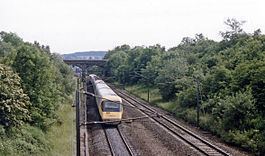Place Clifton 17 December 1846 Opened as Clifton | Area Eden Platforms in use 2 | |
 | ||
Pre-grouping London and North Western Railway Post-grouping London Midland and Scottish Railway 1 February 1887 Renamed Clifton & Lowther Original company Lancaster and Carlisle Railway Similar Clifton Moor railway st, Gaisgill railway station, Bromfield (Cumbria) railway st, Black Dyke Halt railway st, Cumberland and Westmorl | ||
Clifton & Lowther railway station was a station on the Lancaster and Carlisle Railway (L&CR) south of Penrith near to the village of Clifton. Although it was the original terminus to cross Pennines rail traffic on the Eden Valley Railway, it was rapidly by-passed by a new line and junction. The station, which was on the West Coast Main Line, was treated as a private stop by the Earls of Lonsdale.
Contents
History
The station opened as Clifton railway station on Lancaster and Carlisle Railway in 1846. In 1858 work began to build the Eden Valley Railway between Penrith and Kirkby Stephen via Appleby-in-Westmorland. It would primarily be for mineral traffic but it would also carry passengers. The terminus at the western end of the new line would be Clifton Station. Eden Valley passenger services used an island platform that also served the West Coast Main line. The station also had goods sidings, a turntable, and water tower.
However, even before the Eden Valley line opened, plans were conceived to build a northern junction that would provide a direct link between the industrial areas of West Cumberland and the northeast's coalfields around Durham and Newcastle. The Eden Valley line would provide a direct connection between the Cockermouth & Workington Railway's Workington to Penrith line and the Stockton and Darlington railway.
Although the branch - which had several cuttings, embankments and bridges - was completed to Clifton station, by 1862 permission was given to build the northern connection that would allow trains from Penrith to run directly onto the Eden Valley line. When the new route opened in 1863, a new Clifton station was built on the northern section (it was later renamed Clifton Moor in 1927). Eden Valley trains could now use the northern track as they had been granted running powers on the L&CR line to Penrith.
After 1874, the short southern branch from the Eden Valley Railway to the original Clifton station was closed.
Despite losing its cross Pennine passenger services, the station remained open. In 1887 the station was renamed Clifton & Lowther. It closed to passenger services in 1938 and to freight in 1951.
Private station
When Clifton first opened Henry Lowther, 3rd Earl of Lonsdale, who lived in the nearby Lowther Castle, was permitted to stop any train on demand. When the new Clifton Station (see Clifton Moor) opened in 1863 the railway company built him his own private waiting room. This private agreement was subsequently passed on to future Earls of Lonsdale.
A 1903 article in Railway Magazine noted:
We cannot regard Lowther Railway Station, on the London and North-Western line, as absolutely a private station, but the Earl of Lonsdale, who is the great territorial feudal lord of the district of Cumberland that stretches about Penrith and Askham, has a private agreement with the railway authorities in virtue of which, for certain concessions made with regard to building the station, the land it stands on, etc., he, his family, and guests have the right to have any train stopped at any required times at Lowther Station, whether such trains are expresses or not, and whether they may be timed to stop near or far from Lowther Station.
It will easily be seen, therefore, that, such a "right" is tantamount in many ways to owning a private railway station, with the additional advantage that somebody else keeps up the maintenance of the place! Yet "Clifton and Lowther Station" is open to the public, and so is not absolutely a "private" station.
